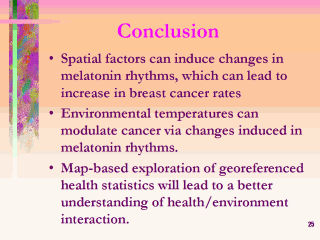 |
In summary, we
have combined data and techniques from the areas of environmental physics
and cancer epidemiology to explore the hypothesis that spatial environmental
factors can induce changes in melatonin rhythms, which can lead to increases
in breast cancer rates. The results are interpreted as evidence that
temperatures can modulate cancer via changes induced in melatonin rhythms.
The study provides a valuable reference information for clinicians and
health administrators, as well as baseline for more detailed studies of
patient survival for individual environmental/geographical sites. The
earlier the cancer is detected, the smaller the chance that it already has
spread beyond the limited primary focus. This implies that the extend of
intervention needed is lesser and the prognosis improved. Map-based
exploration of georefrenced health statistics will lead to a better
understanding of health/environment interaction. By utilizing Geographical
Information System technology we can enhance our ability to manage, estimate
and predict breast cancer distribution.
|
